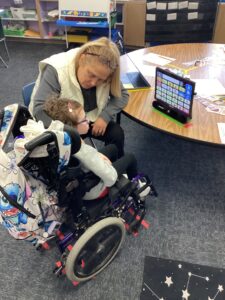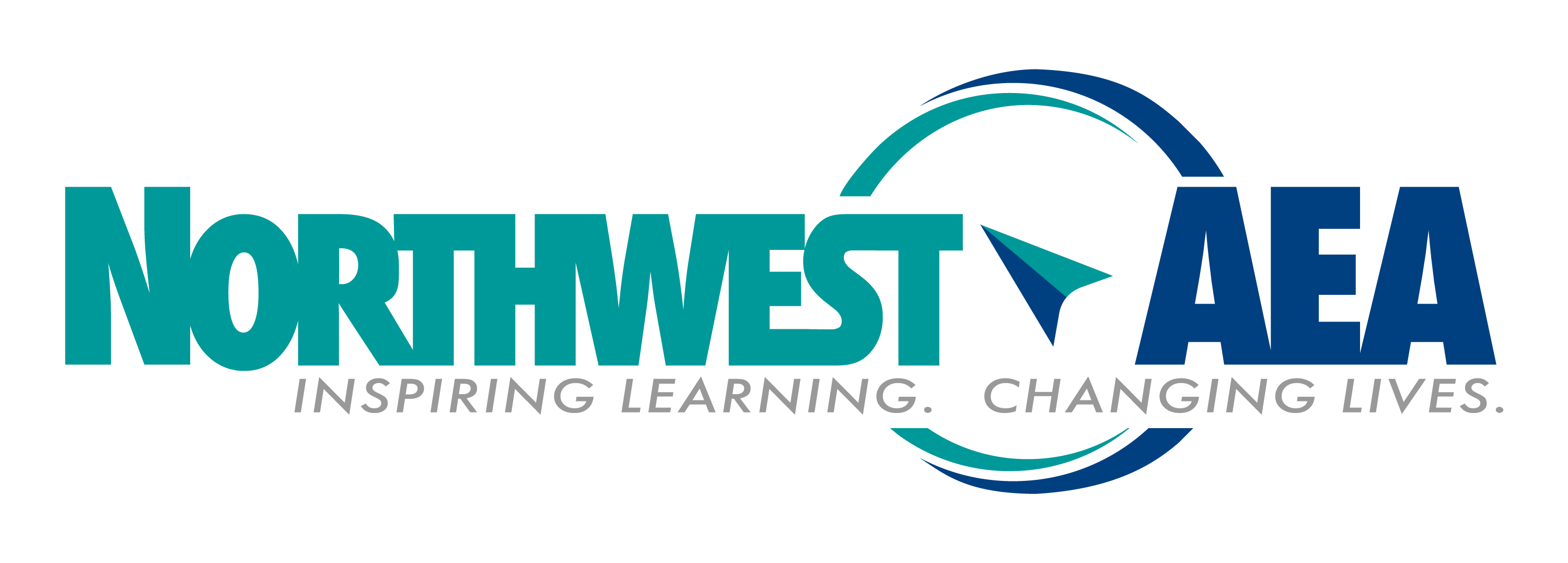November is Assistive Technology Month. Assistive Technology (AT) is a broad term that encompasses a wide variety of devices, equipment, or systems used to help people with and without disabilities perform tasks with greater ease and/or independence. The beauty of AT is truly that there are so many different options available to fit anyone’s needs. AT can range from low-tech (e.g., pencil grips, slant boards, walkers) to high-tech (e.g., voice recognition software, augmented communication devices, power wheelchairs). The specific type of AT that is right for a student will depend on his/her individual needs and abilities. In fact, individual needs will most likely change over the course of a lifetime due to health changes, growth, environmental changes, etc.
| Anya Parmeter is in the second grade at West Sioux Elementary. Anya was diagnosed with Rett Syndrome the week before she turned two after her parents and doctors noticed she was not meeting typical milestones and was losing abilities she had previously acquired. Anya started Occupational Therapy (OT) and Physical Therapy (PT) with the AEA at 13 months (before her diagnosis). She has received care from OT and PT services for 8 years, speech for 5 years, and they have done more than just provide therapy sessions.
|
 |
Anya’s mom, Kylie Parmeter stated, “They (AEA) have assisted in Anya's wheelchair, paperwork for the Iowa Disability Waiver, preschool intervention, classroom intervention, her sit-to-stand device, and most recently her eye gaze device. They also provide great communication with her out-patient OT/PT and Speech Therapist through the hospital. Their care and support has been a huge help to us as a family. Not only are they assisting in care for Anya, but they advocate for her and the devices and services she needs to succeed and give a better quality of life.” Anya is an excellent example of the variability in AT needs.
At this time, Anya’s stander is a device that allows her to be in an upright standing position for longer periods of time. This allows her to be at the level of her peers and access different activities during her day (smart board). Anya’s wheelchair allows her to access her education, home and community environments. It gives her the support that she requires in order to be in an upright position so she can use her communication device and to interact with her peers.
Anya uses a mix of vocalizations, conventional gestures, picture cards with symbols, and most recently a speech generating device with eye gaze technology to communicate. Kylie stated, “Her [Anya’s] communication device has been a long term goal since the age of 3. Last fall, between her special education teacher and the help of AEA, Anya was prepared for a trial device. The trial went exceedingly well and was approved to purchase one. It [the speech generating device] is giving her the freedom to express her wants, needs, thoughts, likes and dislikes, and how much she truly understands about the content she is being taught.” Anya’s communication needs change throughout the day for a variety of reasons (e.g., health, level of alertness, environment, etc.); therefore, Anya continues to need access to a variety of AT for communication purposes throughout her day.
Sydnee Thiesen, Anya’s special education teacher uses a variety of AT when instructing Anya at school. Visuals, picture symbols, display boards, specific table heights, and adapted books are just a few examples of what is being used on a daily basis to help Anya access instruction and her environment. Sydnee has adapted and created AT devices that fit Anya’s need at this time. One creative adaptation that Sydnee has implemented is taping the location of Anya’s wheelchair, communication device, and table to ensure that Anya’s eye-gaze device is calibrated correctly to ensure accurate communication attempts. AT can and should be used or adapted to fit the needs of the user.
Collaborating as a team ensures that Anya has access to her educational environment and equipment through the use of AT devices. It also encourages participation and engagement with her peers and the activities throughout her day. Teams need to remember that AT should not be a “fixed” support. Teams need to continually monitor and adapt to the student and his/her needs.
Jordan Bursell, NWAEA Speech-Language Pathologist
Amber Coburn, NWAEA Physical Therapist
